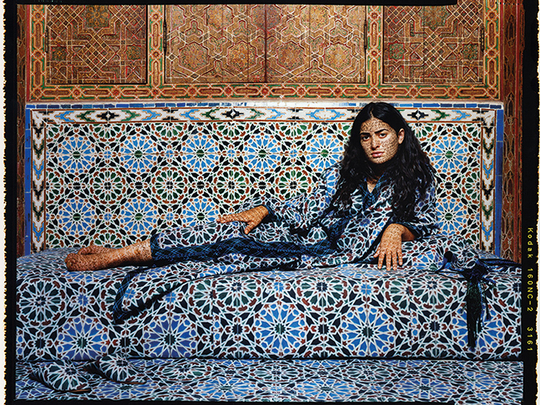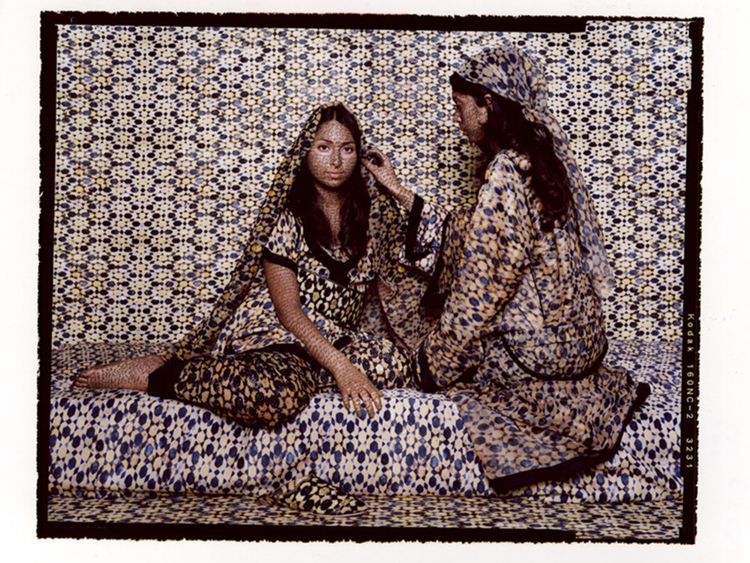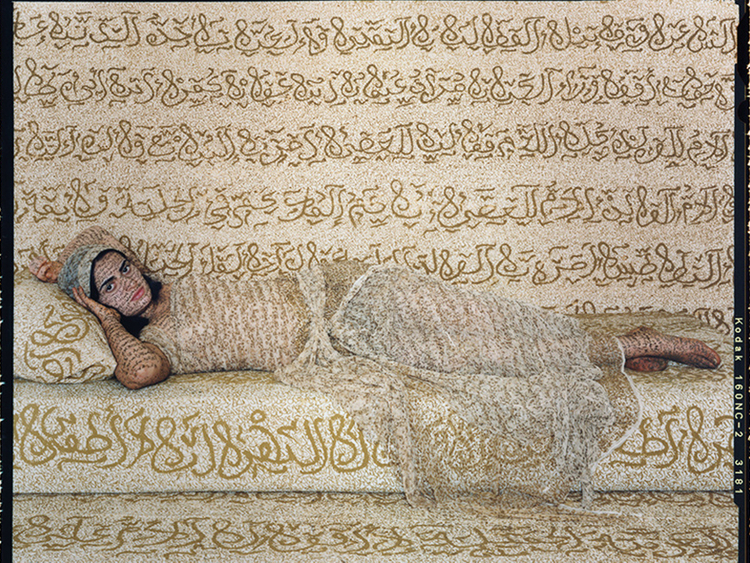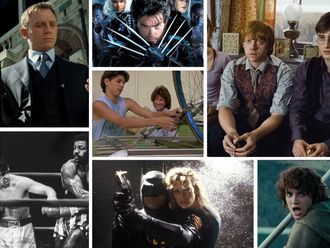
New York-based Moroccan artist, Lalla Essaydi is presenting her first solo exhibition in the region, Still in Progress, at Leila Heller Gallery Dubai. The show features photographic works from various series created by the artist between 2003 and 2013. It offers visitors a rare opportunity to see very large size works from her major series in one place, illustrating the evolution of her distinct vocabulary, and her unique way of addressing socio-cultural themes.
Essaydi’s beautiful and thought provoking photographs, all featuring oriental women in oriental settings, are created by a complex process that includes painting, calligraphy, elaborate costumes and interiors, and carefully staged performances. The women are placed in traditional surroundings, but they look strong and confident, defiantly returning the viewers’ gaze. In a signature touch, the artist covers their bodies, and their surroundings with calligraphy-like writing, using henna instead of ink, making a powerful statement about the conflicts faced by women, and their position in society.
Essaydi uses an analogue camera and she deliberately includes the uncropped white borders of the film in her prints to highlight the fact that her settings and characters are fabricated, yet they are based on historical, social and cultural facts, thus mocking the imaginary scenes of oriental women in harems portrayed by Western artists in well-known Orientalist paintings.
The earliest works in the show are from the Converging Territories series from 2002, where Essaydi began to use henna to write calligraphic texts in Kufic style on the faces, bodies, clothes and surroundings of the women in her photographs. The illegible writing represents the unheard voices of women and their individual and collective stories.
Later, in the Les Femmes du Maroc series, from 2005 -2007, she arranged her models in poses directly inspired by 19th century Orientalist paintings by artists such as Ingres, Delacroix and Gerome. Once again, she used henna to cover everything from the walls, curtains and sheets to the bodies and diaphanous garments of her ‘Odalisques’ with layers and layers of calligraphic text, concealing their bare skin.
“By reclaiming the rich tradition of calligraphy and interweaving it with the traditionally female art of henna, I have been able to express, and dissolve the contradictions I have encountered in my culture between hierarchy and fluidity, public and private space, and the richness and confining aspects of Islamic traditions,” Essaydi says.
In the Harem series from 2009, Essaydi has playfully explored the function of women as decorative features within the context of local architecture, and the physical and psychological environment of the home and harem. The series was shot in the harem quarters of the magnificent Dar al Basha palace in Marrakesh, and Essaydi designed clothes for her models that matched with the geometric ceramic mosaics on the floor and walls and the intricate carving on the wooden doors and windows of the palace. With their faces, feet and hands covered with calligraphic texts, and their clothes matching the background, the women just blend into their environment.
“Odalisque is a Turkish word, which means ‘to belong to a place’. The women in these pictures have become literal odalisques, ‘caged’ amongst other acquisitions in the ‘cabinet of curiosities’ of the male dominion, the harem,” the artist says.
Later in 2012, for the Harem Revisited series, Essaydi created dresses for her models and drapes for the background from vintage textiles, loaned to her by the Nour and Boubker Temli collection. The rich, luxurious Moroccan fabrics, dating from the 17th to the early 20th century, were meant to be used for weddings, and to decorate palaces and the harem area. By making her models wear the kind of clothes women would have worn during the period when the famous Orientalist paintings by European artists were executed, Essaydi further highlights the false narratives these artists depicted. But she also subtly draws parallels between women and precious objects that are restricted to special spaces.
The show also includes works from the Bullets, and Bullets Revisited series, which she created between 2009 and 2014. The images look quite similar to the Harem series, but a closer look reveals that every item, from the glittering clothes and jewellery of the models to the mosaics on the walls are made from carefully cut and polished bullet casings. For some pictures Essaydi meticulously sewed together thousands of bullet casings to create a shiny golden mantle, draped from ceiling to floor.
This series marks a shift in her work as she takes her veiled Odalisques out from the confines of their traditional environment into the contemporary world, and puts the focus firmly on them. However, the shiny bullets are a reminder of the perils that await the women in a world ravaged by war and destruction. “Beauty is quite dangerous, as it lures the viewer into accepting fantasy,” the artist says.
In some of Essaydi’s photographs, the women are seen holding a henna cone in their hand, suggesting that the act of writing their stories is still in progress, as the title of the show indicates. “I want my work to be as vividly present, and yet as elusive as ‘woman’ herself, not just because she is veiled or turns away, but because she is still in progress,” Essaydi says.
Still in Progress will run at Leila Heller Gallery, Dubai in Alserkal Avenue until August 15.














